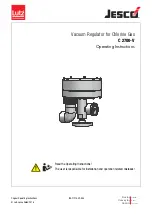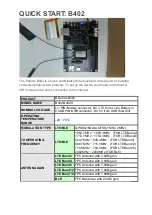
Safety
General warnings
5
© Lutz-Jesco GmbH 2016
Subject to technical changes.
160426
Vacuum Regulator for Chlorine Gas
C 2700-V
Operating Instructions
BA-21210-02-V05
2 Safety
2.1 General warnings
The following warnings are intended to help you to eliminate the
dangers that can arise while handling the device. Risk prevention meas-
ures always apply regardless of any specific action.
Safety instructions warning against risks arising from specific activities
or situations can be found in the respective sub-chapters.
2.2 Information about chlorine
Chlorine is a hazardous substance. The chemical element chlorine is a
greenish-yellow, toxic gas with a pungent odour, which can be detected
in the air at concentrations below 1 ppm (= 1 ml/m³).
Chlorine is 2.5 times heavier than air and accumulates at ground level.
Chlorine is extremely toxic for water organisms. The reason for the
toxicity of chlorine is its extraordinary reactivity. It reacts with animal
and vegetable tissue and thus destroys it.
Air with a chlorine gas content of 0.5 – 1% leads to a quick death in
mammals and humans as it attacks the respiratory tract and the pulmo-
nary alveolus (formation of hydrogen chloride or hydrochloride acid).
DANGER
Danger to life from chlorine poisoning!
Chlorine is poisonous. In severe cases, breathing in chlorine may
lead to death. It irritates the eyes, the respiratory system and the
skin.
Use sufficient personal protective equipment.
When carrying out any work on the system, use a respirator
mask with a Type B gas filter that complies with EN 14387.
Always comply with the accident prevention regulations that
apply at the place of use.
Get rid of leaks without delay. You must get rid of even very
minor leaks without delay. Together with the humidity, chlorine
forms hydrochloric acid and corrosion rapidly results in
increased leakage.
Only use chlorine-resistant seals.
Only use seals once. Reusing them leads to leaks.
DANGER
Danger to life from chlorine poisoning!
If chlorine gas escapes, a filter mask is ineffective, since it is not a
self-contained breathing apparatus.
If chlorine gas escapes, wear type 2 self-contained breathing
apparatus that complies with EN 137.
DANGER
Danger to life from chlorine poisoning!
Chlorinators without gas warning devices represent an increased
safety risk since escaping chlorine gas can either not be detected
at all or not in good time.
Install a gas warning device.
WARNING
Increased risk of accidents due to insufficient qualifica-
tion of personnel!
Chlorinators and their accessories must only be installed, operated
and maintained by personnel with sufficient qualifications. Insuffi-
cient qualification will increase the risk of accidents.
Ensure that all action is taken only by personnel with sufficient
and corresponding qualifications.
Prevent access to the system for unauthorised persons.
NOTICE
Damage to the system due to the formation of hydro-
chloric acid
Chlorine gas is highly hygroscopic. This means that humidity enters
the system at any open connection on devices or pipes, which
results in the formation of hydrochloric acid and contamination.
Damage to the devices is then inevitable.
Keep all the connections (in the vacuum system too) closed at all
times.
NOTICE
Faults due to insufficient chlorine quality
Impurities in the chlorine gas result in build-ups in devices and
valves and can chemically attack the components. This can cause
malfunctions.
Only use technically pure chlorine which satisfies the following
requirements:
- Chlorine mass content of at least 99.5%
- Max. chlorine water content of 20 mg/kg
Chlorine as per EN 937 satisfies these requirements.






































